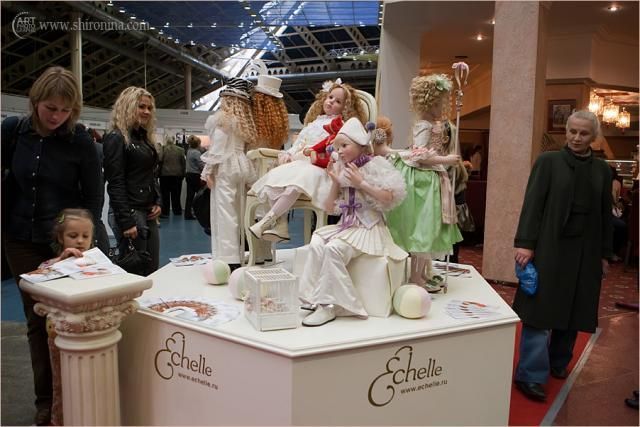|
|
International Doll Salon, Moscow, Russia
|
• Industrial era
During the 19th century dolls' heads were often made of porcelain and combined with a body of leather, cloth, wood, or composite materials, like papier-mâché or composition, a mix of pulp, sawdust, glue and similar materials. With the advent of polymer and plastic materials in the 20th century, doll making largely shifted to these materials. The low cost, ease of manufacture and durability of plastic materials meant new types of dolls could be mass produced at a lower price. The earliest materials were rubber and celluloid. From the mid-20th century soft vinyl became the dominant material, in particular for childrens dolls. Beginning in the 20th century, both porcelain and plastic dolls are made directly for the adult collectors market. Synthetic resins like polyurethane resemble porcelain in texture and are used for collectible dolls.
Colloquially the terms porcelain doll, bisque doll and china doll are sometimes used interchangeably. But collectors make a distinction between china dolls, made of glazed porcelain, and bisque dolls, made of unglazed bisque porcelain. A typical antique china doll has a white glazed porcelain head with painted molded hair and a body made of cloth or leather. The name comes from china being used to refer to the material porcelain. They were mass produced in Germany, peaking in popularity between 1840 and 1890, and selling in the millions. Parian dolls were also made in Germany, from around 1860 to 1880. They are made of white porcelain similar to china dolls but the head is not dipped in glaze and has a matte finish. Bisque dolls are characterized by their realistic, skin-like matte finish. They had their peak of popularity between 1860 and 1900 with French and German dolls. Antique German and French bisque dolls from the 19th century were often made as children's playthings, but contemporary bisque dolls are predominantly made directly for the collectors market.
Up through the middle of the 19th century, European dolls were predminantly made to represent grown-ups. Child-like dolls and the later ubiquitous baby doll did not appear until around 1850. But by the late century baby and child-like dolls had overtaken the market. Realistic, lifelike wax dolls were popular in Victorian England.
|
|









